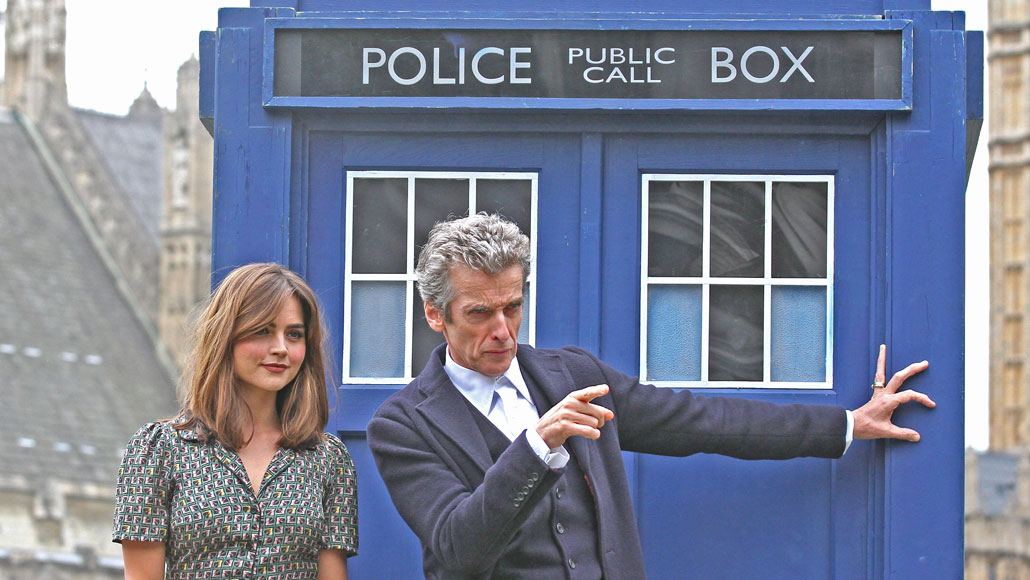
The TARDIS and other fictional time machines make time travel look relatively easy (Peter Capaldi and Jenna Coleman are shown promoting the BBC’s Doctor Who). But just because it’s permitted by the laws of physics, doesn’t mean it’s practical.
Twocoms/Shutterstock
In many universes, typically those on TV shows or in movies, time travel is not much more difficult than driving downtown in any major city during rush hour. Sure, the traffic can get gnarly, but no law of physics prevents you from reaching your destination eventually.
In real life, time travel isn’t so easy. In fact, it’s probably impossible, a fantasy more farfetched than visiting Alice’s Wonderland, finding gold at the end of a rainbow or cleansing all the hate speech off of Facebook.
Yet time travel does not necessarily violate the laws of physics. In Einstein’s theory of gravity — general relativity — space and time are merged as spacetime, which allows for the possibility of pathways that could bend back to the past and loop back to the future.
Such paths are known as closed timelike curves. They’re a little like great circles around the surface of the Earth — if you start out in one direction and keep going straight, eventually you come back to where you started from. In that case the Earth’s curvature guides you back to your previous point in space; with closed timelike curves, the geometry of spacetime guides you back to an earlier moment in time.
Nobody thinks that general relativity’s time loops would be practical for time travel even if they are possible. For one thing, they might exist only under certain circumstances — the universe would have to be rotating, and not expanding — as the mathematician Kurt Gödel showed in the 1940s. But the universe is expanding, and probably isn’t rotating, so that dampens the prospects for revisiting the Stone Age or acquiring a pet dinosaur.
Besides, even if such pathways did exist, building a ship to traverse them would cost more than all the DeLoreans (and all other transportation vehicles) ever made. It would need a cruising speed of 140,000 miles per second. And with no place to stop for gas (or whatever), the fuel tank would have to be more than a trillion times the size of an oil tanker.
So for practical purposes, time travel’s time has not yet arrived. But even if it’s possible only in principle, the potential ramifications for the basic physics of the universe might make it worth the time to investigate it. Time loops might not enable you to traverse the cosmos in a TARDIS, but perhaps could still help you understand the cosmos more deeply.
A first step would be to attempt to figure out exactly what the relevant laws of physics really are. Einstein’s general relativity is great, but indubitably not the last word about the physics of the universe. After all, it coexists uneasily with quantum mechanics, which rules the subatomic world and presumably, since everything is made of subatomic stuff, the rest of the universe as well. Whether the quantum–general relativity combo truly permits time travel might depend on what the ultimate correct theory combining the two turns out to be.
Several candidate theories have been developed for merging general relativity and quantum mechanics into a unified theory. It’s an open question whether these candidates would allow time travel in something like the way general relativity does, philosopher Christian Wüthrich of the University of Geneva notes in a new paper.
It’s possible, he says, that a theory that supersedes general relativity might still in some way include the equivalent of general relativity’s timelike loops. And even if the basic theory does not include such loops, they still might emerge in practice.
“Although the fundamental theory would then remain inhospitable to time travel itself, it would tolerate the possibility of time travel at some other, less fundamental, scale,” Wüthrich writes in his paper, posted online in June. “Depending on what the relationship between the fundamental theory and emergent spacetime may be in each case, we may find that the emergent, macroscopic spacetime structure permits time travel.”
Reviewing the major proposals for quantum gravity theories does not provide a lot of hope, though. One approach, known as causal set theory, requires sets of events to be ordered in a proper cause-and-effect relationship. So its central idea seems to rule out closed timelike curves.
Another popular approach, known as loop quantum gravity, envisions space to be constructed of fundamental loops (kind of like “atoms of space”). This view has encountered technical difficulties, one of which is how to work time into the picture with space. “Thus, we seem to be faced with a temporally innocuous structure in which no meaningful sense of time travel is permitted,” Wüthrich writes.
It’s possible that the networks of these “atoms of space” could produce high-level spacetime that did contain closed timelike curves. But analysis of the details at this stage of loop quantum gravity’s development does not offer much reason for optimism, Wüthrich concludes.
Time travel’s future might look a little brighter if the correct approach to quantum gravity turns out to be string theory, currently the most popular contender. In string theory, matter’s basic particles are tiny vibrating snippets of energy, called “strings” because they extend in one dimension. Multiple versions of string theory have been constructed, suggesting that they are different manifestations of a more fundamental master theory known as M-theory.
“As M-theory does not yet exist, it is impossible to determine its verdict on time travel,” writes Wüthrich. But investigations of various string theory scenarios do suggest that the ultimate theory would, in fact, naturally incorporate closed timelike curves.
Even if time loops exist in the fundamental theory, though, there’s still no guarantee that they would be preserved in the emergent large-scale spacetime that would be relevant in real life. For that matter, Wüthrich points out, predicting the existence of time travel loops might be taken as evidence against the theory, considering the serious likelihood that time travel really isn’t possible at all.
So whether general relativity’s time loops will survive in a deeper theory remains an open question. “A more fundamental theory may well admit structures amounting to closed timelike curves and thus permit time travel,” Wüthrich asserts. “This clearly remains a live option at the present stage of knowledge.”
In any case, investigating whether quantum gravity theories retain general relativity’s time travel loophole can illuminate many tough questions that must be answered to develop a successful theory and understand how it relates to general relativity. “For this reason alone,” Wüthrich writes, “the question of time travel beyond general relativity is worth our while.”








